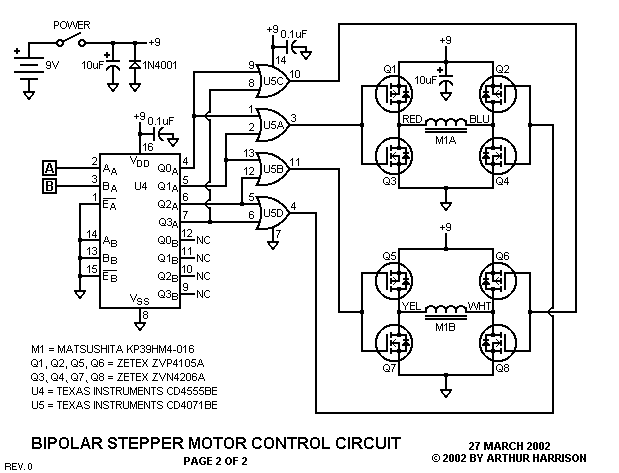POST ISSUE: 8 of 2016_11_02
HI CB,
You don't post too often on ETO.

Where are you at? If you put it next to 'Location' on your user page it will show in the box at the left of your posts. It helps us when answering questions to know where members are.
I haven't analyzed the logic or functional design of the two circuits you posted, but I have done a parametric analysis and I am afraid to say that:
(1) The MOSFETs (ZVN4206A/ZVP4105A) in the circuit #1 (lower left) are not man enough for the job and will probably blow.
(2) The NOSFETs (IRLML2803/IRLML6302) in circuit #2 are even less adequate and will blow instantly with the size of stepper motor you imply.
(3) Driving MOSFET gates with CD4000 series logic is OK for low speed switching, but for higher speeds it is inadequate, due to the huge effective input capacitance of MOSFETS, especially as you are driving two MOSFET gates with one CMOS drive signal.
(4) There are no gate drive stopping/shaping resistors.
(5) You plan to use 30V to 35V supply rails, but the IRLML6303 NMOSFET only has a VDSmax of 20V. A 60V and above, NMOSFET would be advisable
(6) You plant to use 30V to 35V supply rails, but the IRLML2803 PMOSFET only has a VDSmax of 30V. A 60V, and above PMOSFET would be advisable
Note that, for various reasons, you cannot use a 30V VDXmax MOSFET on a 30V supply line, for example. Similarly, you could not use a 1A IDmax MOSFET to switch a 1A load, for example. You must keep within the bounds of the MOSFET's safe operating area (SOA). If the MOSFETs data sheet does not mention SOA, you have to take a guess, or preferably chose a properly specified device.
(7) The IRLML2803PbF data sheet does not include a maximum VGSth value, which means that it is impossible to design this device into a circuit.
You ask about the L297 and L298: they are both widely used bridge chips and are well behaved, but you must keep within the maximum ratings listed on the data sheets. The L297 is only suitable for relatively light loads, but the L298 is much more manly. Making your own bridge will give you more flexibility and potential voltage/power capability and, for your intended application, is the best way to go, I would think.
I just had a quick look at the functional design and would advise that it would be far better to eliminate the two enable NMOSFETs and do the enable function by logic. That would mean driving each of the four MOSFET gates, in each of the two H bridges, separately (which would be a good move anyway).
spec
DATASHEETS
ZVN4206A: http://www.diodes.com/_files/datasheets/ZVN4206A.pdf
ZVP4105A: https://www.diodes.com/_files/datasheets/ZVP4105A.pdf
IRLML6302PbF: https://www.infineon.com/dgdl/irlml6302pbf.pdf?fileId=5546d462533600a4015356688c702627
IRLML2803PbF: https://www.infineon.com/dgdl/irlml2803pbf.pdf?fileId=5546d462533600a4015356682aff260f
L297: https://www.st.com/content/ccc/reso...df/jcr:content/translations/en.CD00000063.pdf
L298:
https://www.st.com/content/ccc/reso...df/jcr:content/translations/en.CD00000240.pdf







